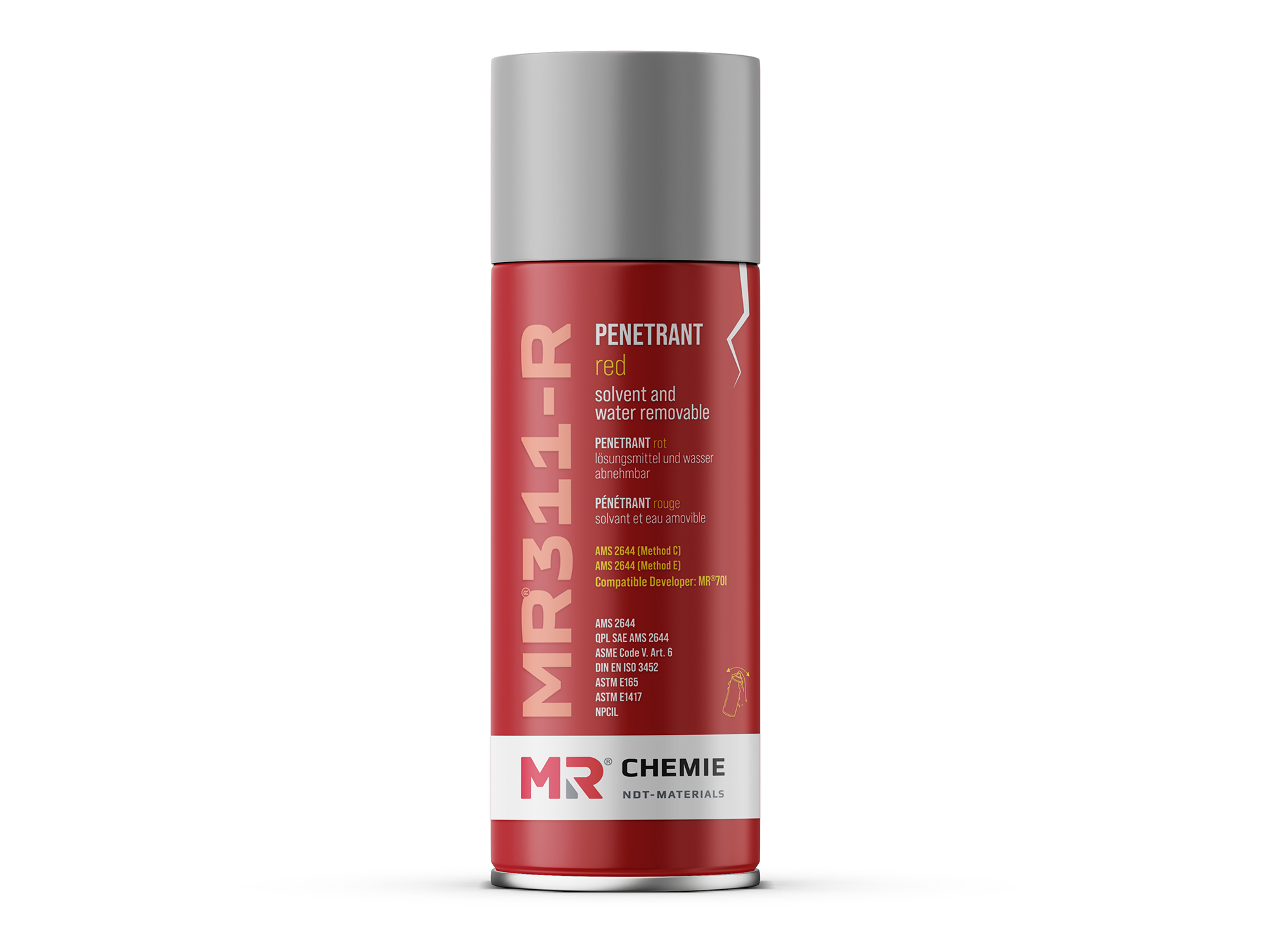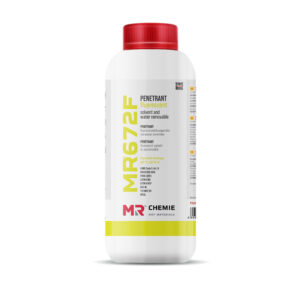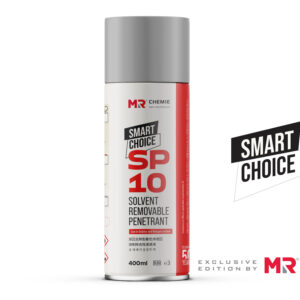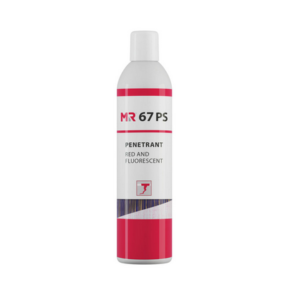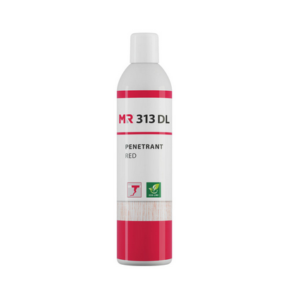MR®311-R, Penetrant – Red; Solvent & Water Removable
MR®311-R (AMS) is a Type II solvent and water removable red colour penetrant ideal for general industrial dye penetrant testing. It exhibits outstanding penetrating characteristics along with dark red indications which provides maximum reliability in locating surface open flaws and discontinuities. Typical application include casting, forgings, leak testing, welds, pressure vessels and general metal works.
| SKU | Pack Size | Case Size |
| 2511-0003 | Aerosol 400ml | 10 |
| 2511-0041 | Bulk 1L | 6 |
| 2511-0069 | Bulk 5L | – |
Additional information
| Properties | Appearance – red oily liquid |
|---|---|
| Approvals | AMS 2644 |
| Family Testing | Penetrant – MR311-R |
| Recommended Usage | NDT Method – Dye Penetrant Testing |
| Reference Test Blocks | Reference test block type 1 (Ni-Cr panel – 30µm & 50µm) |
Features
- Dark red, clear indications under white light
- Free of aromatics, oil-based
- Over-wash resistance
- Superior reliability
- NPE-free
- Phthalate-free
- Superior surface wetting
- Low odour
- Outstanding penetrating capability
- Instant indications - high capillary action
- Easy to apply and easy to clean
- Low toxicity
- Suitable for all metals (suitability for plastics & ceramics requires testing prior to use)
How it Works
Penetrants in NDT work by taking advantage of the capillary action principle, which is the ability of a liquid to flow into narrow spaces without the assistance of, or even in opposition to, external forces like gravity.
The penetrant used in NDT is a liquid that is applied to the surface of the material being inspected and allowed to seep into surface-breaking defects, such as cracks or porosity. After a certain amount of time, the excess penetrant is wiped off the surface, leaving only the penetrant that has seeped into the defects. A developer is then applied to the surface, which draws the trapped penetrant out of the defects, making them visible to the naked eye. The developer also amplifies the penetrant's fluorescence, making the defects visible under UV light.
The penetrant works by using a combination of capillary action, surface tension, and viscosity to penetrate the surface-breaking defects. The penetrant liquid contains a dye or fluorescent material that allows the defects to be seen under white or UV light, respectively.
GHS
Aerosol UN Model Regulation - UN 1950 AEROSOLS, 2.1 Bulk
Bulk

FAQ
Q: What is penetrant testing in NDT?
A: Penetrant testing, also known as dye penetrant inspection, is a non-destructive testing (NDT) technique used to detect surface-breaking defects such as cracks, porosity, laps, and seams on the surface of solid materials.
Q: How does penetrant testing work?
A: Penetrant testing works by applying a liquid dye penetrant to the surface of a material. The penetrant flows into any surface defects and is allowed to soak for a specified time. Excess penetrant is then removed, and a developer is applied, which draws the penetrant out of the defects and makes them visible.
Q: What are the advantages of penetrant testing?
A: Penetrant testing is a relatively simple and cost-effective method for detecting surface defects on a wide range of materials. It can be used on a variety of surface geometries, including complex shapes, and is capable of detecting very small defects.
Q: What are the limitations of penetrant testing?
A: Penetrant testing is only capable of detecting surface-breaking defects and is not effective for detecting subsurface defects. It also requires a clean and dry surface to be effective and may not be suitable for use on certain materials, such as porous materials.
Q: What are the different types of penetrant testing?
A: There are three types of penetrant testing: Type I (Fluorescent), Type II (Visible), and Type III (Visible & Fluorescent). Each type uses a different type of penetrant and developer and has different application and removal procedures.
Q: What are some common applications of penetrant testing?
A: Penetrant testing is commonly used in industries such as aerospace, automotive, and manufacturing to detect surface defects in materials such as metal, plastic, and ceramic components. It is also used in the inspection of welds, castings, and forgings.
Q: What is the sensitivity of a Visible Penetrant?
A: The typical sensitivity of a visible penetrant is Level 2; as dictated by the EN-ISO 3452-2 standard.Q: What is the sensitivity of a Fluorescent Penetrant?
A: The typical sensitivity classes of a fluorescent penetrant are Level 0.5, Level 1, Level 2, Level 3 & Level 4; as dictated by the EN-ISO 3452-2 standard.
Q: What is the difference between Type testing, Batch Testing and In-use testing?
A: Type testing
When seeking approval for a penetrant in accordance with material specifications such as AMS 2644 and EN ISO 3452-2, the penetrant manufacturer is responsible for getting the product Type tested. This involves sending a sample of the penetrant off to an independent laboratory for verification against a comprehensive set of standard tests.
Batch testing
During the routine manufacture of a penetrant and its associated consumable products, it is a requirement under material specifications such as AMS 2644 and EN ISO 3452-2 to carry out a number of batch-specific tests, including flash point, viscosity and fluorescent brightness (Type 1 systems only). These specifications also specify the sampling rate and dictate that we should publish these results on a certificate of conformance. For MR Chemie penetrants, cleaners, developers and emulsifiers, these certificates of conformance are referred to as Batch Inspection Certificates (or) Test Certificates
In-use testing
When a penetrant is being used, there are a set of in-use tests that need to be carried out by the customer. ASTM E1417 has established standards for performance checks for in-use materials.
Q: How is sensitivity level of penetrant defined?
A: The sensitivity of a penetrant is not just simply its ability to find different sized cracks/defects; it also relates to aspects such as the type of surface finish. For example, on a rough casting you would not want to use a high sensitivity penetrant as it would be too difficult to remove, and you would see a lot of penetrant in the background. Conversely, on a highly polished part you would not want to use a low sensitivity penetrant as the risk of over washing and removing penetrant from the cracks/defects would be high. The sensitivity of a penetrant is ultimately determined by the independent laboratories that assess the penetrant in accordance with material specifications such as AMS 2644 and EN-ISO 3452-2.
Q: What is the best alternative to an aerosol LPI penetrant that can be used in situations where flammability represents a hazard?
A: MR Chemie offers a range of Eco-Line products like MR67DL, MR313DL in aerosols for use where flammability is an issue. These products are equipped with non-flammable carrier media and propellents. Alternatively, products in bulk can also be opted for.Q: What recommendations does MR Chemie offer about penetrant dwell time?
A: Minimum penetration time is 2 to 5 minutes, with 10 minutes being adequate for most situations. Lower temperatures will thicken the penetrant and require longer penetration times. Higher temperatures will lower the viscosity of penetrant and requires much lesser penetration time. Please note that this information is for guidance purposes only. With any penetrant – fluorescent or visible – the penetrant dwell time will be dependent on the type of material (metals, plastics, ceramics, castings, forgings, rolled materials, welds, etc) as well as temperature. We recommends that prior testing is carried out when inspecting different material types, or when inspecting at different temperatures, to establish the most appropriate dwell time.Q: Can penetrants be used to inspect ceramic, plastic and/or composite materials?
A: Whilst MR Chemie penetrants can be used on ceramic, plastic and/or composite materials, the dyes within them can cause staining. It is also possible that the penetrant will soften or even dissolve the base material of some plastics. We recommend testing prior to use for compatibility.
Q: Does MR Chemie have any recommendations on how to remove penetrant residue from test panels?
A: Over time, penetrant residue can build up within test panels, which will affect their performance. Also, in a hard water area, it is possible to get salt and limescale deposits within the panels. Our recommendations on cleaning are:
- Pre-soak the panels in hot water (ca. 50-70ºC) for a few minutes. This will soften any residual penetrant.
- Use a polar solvent such as acetone, methyl ethyl ketone (MEK) or isopropanol in combination with an ultrasonic bath. This way you get a combination of the solvent action and also a vibrational effect to release any residues. Prior to doing this, we recommend that you carry out a workplace risk assessment to minimise or eliminate any risk to an operator.
- If you are in a hard water area, you could also use a weak solution of a limescale remover. Avoid using strong acids or prolonged contact with a limescale remover as this will cause damage to the chrome plating. Ensure that all traces of limescale remover are removed by rinsing with deionised water.
- Ensure that the panels are fully dried before reusing.
Q: How should I dispose of empty aerosol cans?
A: The material can be disposed off according to the local regulations. Further details are available in our MSDS.
- Flammable
- Non-Flammable
- Aerospace
- Nuclear Power
- General Industry
- Others
